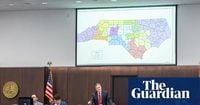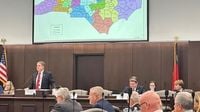North Carolina has become the latest flashpoint in a nationwide battle over congressional redistricting, as Republican lawmakers in Raleigh pushed through a new map on October 21, 2025, that could dramatically reshape the state’s political landscape ahead of the 2026 midterm elections. The move, which follows a call from former President Donald Trump for GOP-led legislatures to secure additional seats in Congress, has set off protests, fierce debate, and looming legal challenges over allegations of gerrymandering and the dilution of Black voting power.
The North Carolina Senate approved the proposed congressional district map with a 26 to 20 vote, setting the stage for the Republican-controlled House to give final General Assembly approval later in the week. The new map institutes changes to just two out of the state’s 14 districts—District 1 and District 3—while leaving the rest untouched. The most controversial change targets District 1, which has for more than three decades elected African American representatives and includes several majority Black counties. Under the new plan, District 1 would shift from a swing district, where Democrat Don Davis narrowly won in 2024 by less than two percentage points, to a seat that leans Republican, with the Trump vote share increasing from 51% to 55% based on 2024 data.
Senate leader Phil Berger, a key architect of the plan, justified the move by referencing what he described as long-standing Democratic efforts to draw Republicans out of power in other states. “Across the country, Democrat-run states have spent decades ensuring that Republicans would be drawn out of Congress,” Berger said, according to WTVD. “North Carolina Republicans will not sit quietly and watch Democrats continue to ignore the will of the people in an attempt to force their liberal agenda on our citizens. This new map respects the will of the North Carolina voters who sent President Trump to the White House three times.”
Republican Deputy President Pro Tempore Ralph Hise was even more direct about the political motivation: “The motivation behind this redraw is simple and singular: draw a new map that will bring an additional Republican seat to the congressional delegation,” Hise said, as reported by CNN. He framed the effort as a necessary response to actions in blue states, arguing, “We designed these maps... for the purpose of rebalancing this nation, rebalancing Congress, and making sure that North Carolina is as optimized as the other blue states were when they created their districts.”
The national context for North Carolina’s redistricting battle is one of escalating partisan warfare. According to CNN, Republican-controlled legislatures in Texas and Missouri have already redrawn maps to add GOP seats, while Democrats in California have launched a campaign to persuade voters to override maps drawn by an independent commission. President Trump has been a vocal proponent of these efforts, writing on Truth Social, “Thank you to North Carolina’s incredible Republican State Legislators, who just introduced a new, fair, and improved, Congressional Map... This new Map would give the fantastic people of North Carolina the opportunity to elect an additional MAGA Republican in the 2026 Midterm Elections, which would be A HUGE VICTORY for our America First Agenda, not just in North Carolina, but across our Nation.”
Yet the GOP’s push in North Carolina has met with fierce resistance from Democrats, voting rights advocates, and members of the public. Hundreds gathered in downtown Raleigh on October 21 to protest the redistricting plan, arguing it would eliminate competitive elections and predetermine outcomes. Anderson Clayton, chair of the North Carolina Democratic Party, told WTVD, “Gerrymandering in the state doesn’t allow for competitive elections to even exist to begin with because it’s already predetermined winners of who’s going to come out in each congressional district. And what we want to see is a free and fair fight right now across North Carolina.”
Democratic lawmakers have been especially vocal about the impact on Black voters. State Sen. Kandie Smith, who represents Edgcombe and Pitt counties, condemned the map’s focus on eastern North Carolina’s Black Belt: “When we go back to talking about we’re not using anything racial, we’re just going to move black people. But it’s not racial? ... People know the truth. They know what’s happening right here.” Congresswoman Alma Adams, a Democrat representing the historically gerrymandered District 12, accused Republicans of trying to “dismantle the district with the largest record of Black Congressional leadership in North Carolina history.”
Eva Clayton, the first Black woman to represent North Carolina in the U.S. House, offered a historical perspective at a news conference, recalling, “It was from 1901 until 1992, 91 years, that a Black citizen happened to be elected. It happened to be myself. The North Carolina General Assembly appears ready now to make it almost impossible for a black citizen to be elected again from North Carolina’s northeastern area.”
Governor Josh Stein, a Democrat, has been outspoken in his opposition, but state law prevents him from vetoing redistricting actions. “They are failing the voters of North Carolina by deciding for them who their congressional representation will be,” Stein said in a video posted on October 20, as reported by WLOS. “It’s outrageous. The people should be choosing our representatives.” Litigation challenging the map is widely expected, with allegations centering on harm to the voting power of Black residents.
Republicans, meanwhile, have defended their actions as a necessary response to Democratic maneuvers in other states. Some pointed to California’s ballot initiative as justification, though critics note that California is only putting redistricting to a public vote rather than unilaterally instituting new maps. “This is a political arms race that Republicans did not start,” Hise said, referencing former President Barack Obama’s support for California’s redistricting initiative.
During heated public comment sessions and legislative meetings, tempers flared. Some members of the public were escorted out after chanting in opposition to the maps. Mark Swallow, of Democracy Out Loud, told legislators, “California hasn’t redistricted a thing... What they’ve done is respond to Texas, which started this fiasco for our country, and put an initiative on the ballot to ask Californians if they should be redistricted. You should do the same... but I doubt that you will because you know that North Carolinians will never approve this scheme. So, you are liars and cheats. That’s what this boils down to. You’re liars and cheats.”
As the House Rules Committee prepared to take up the measure on the evening of October 21, public comments continued to pour in. Don Davis, the Democratic congressman whose district is most affected, lamented to ABC11, “Since the start of this new term, my office has received 46,616 messages from constituents of different political parties, including those unaffiliated, expressing a range of opinions, views, and requests. Not a single one of them included a request for a new congressional map redrawing eastern North Carolina. Clearly, this new congressional map is beyond the pale.”
With the new map poised to give Republicans a solid advantage in 11 of North Carolina’s 14 congressional districts—up from an even 7-7 split under court-ordered maps in 2022—the state’s redistricting battle is far from over. Lawsuits and further political clashes are all but certain. For now, North Carolina stands as a vivid example of the high stakes and deep divisions driving America’s ongoing struggle over who gets to draw the lines of democracy.


